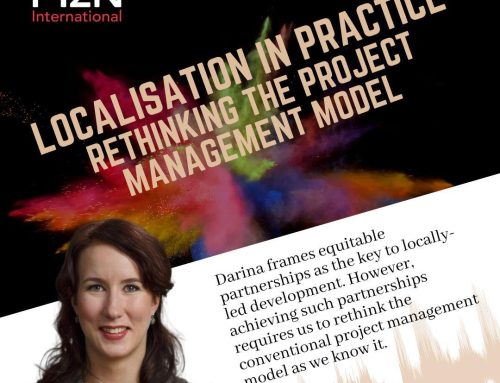Many people have asked me if a funding strategy is really necessary to create financial sustainability for their organisation. My answer is that a funding strategy doesn’t guarantee your financial sustainability, but it could certainly become your compass to ensure you are not losing sight of your financial goals.
In 2020, in the middle of year one of COVID, I had the privilege of working with a tiny but highly successful one-person conservation NGO in the South of Africa to develop its funding strategy. Before we could even get to the funding strategy, we first had to develop the organisational strategy. We then crafted the funding strategy step-by-step for the years to come over a few 2-hour Zoom meetings. Once the first draft of the strategy was on the table, the director euphorically shared with me that, by going through this process, her anxiety levels about where to find funding for the next few years had dropped. Her attitude had completely shifted from that of anxiety and nervousness to feeling in charge and confident.
Developing a funding strategy is much less complex than developing your organisational strategy. As it builds upon your organisational strategy, it is a document that can often be developed relatively quickly in a collaborative way. Even though it includes a strategic perspective, it is full of practical recommendations, concrete targets and tools focusing on financial sustainability. Here are our ten aspects to consider when developing your funding strategy.
10 tips when developing your funding strategy
1. Have your organisational strategy sorted
Only with an organisational strategy in place will you be able to make a plan about the finances you will need to achieve those goals. Your funding strategy has to serve and give realisation to your strategic ambitions. We offer strategic business development for nonprofits. Contact us for more information.
2. Get the right people in the (Zoom) room
Before getting started with your funding strategy, agree on which members of your organisation should participate in the process of developing a funding strategy to ensure a broad buy-in from various stakeholders in the organisation. Besides the funding team, ensure that there is representation from the various departments/sections of your organisations participating in the development of the strategy. I always advise having a senior person from the Finance team, Management and the head of programmes (if you have one). Design your process in a way that you can bring people together for a few shorter sessions, which might make it easier for more people to participate.
One of my clients used to shift the responsibility for fundraising and business development solely to the dedicated team within the organisation. This meant the team could work independently, but anytime there was a shortfall, blame was shifted to them. And when the funding team needed technical or programmatic input for proposals, other members of the organisation complained because they did not understand the complexity of the situation and the reasons why their help was needed. Being inclusive from the onset will spare a lot of sweat and tears in the months to come.
3. Set realistic goals
The first step in designing your funding strategy is setting the goals for your funding and funding operations for the next few years. This task requires a lot of data and someone with a few hours of time and capacity to analyse data. You need to assess your past success rate, available (human) resources, the programmatic and core cost needs. Based on your assessment, formulate ambitious yet realistic financial goals, the type of funders and funding approaches your organisation aims to target and include a section on the ratio of restricted and unrestricted funding.
4. Understand your funding context
Your organisation operates in a real context and environment marked by sociopolitical, environmental, social and political events that impact your funding now and in the future.
Understand the external factors and be aware of the trends and potential threats that might become highly relevant for your funding. For instance, organisations with a majority of bilateral funding might experience how a national election and shift in government, impact development cooperation and ultimately their grants and future income. Organisations often forget that understanding global trends in funding allocation may give you the advantage of knowing which sources of funding will be affected in the future, which can help you to design a strategy that can respond to those constraints.
5. Know the types of funders and funding instruments most relevant to you
What type of funder and which funding instruments have been the most successful for our organisation? Are there new ones that we would like to try? How relevant and enabling are the different types and instruments of funding for our organisation and individual context? These are the types of questions you should answer in your strategy to determine the types and instruments most relevant to your financial future.
6. Positioning
When working on the positioning of your organisation, think about it as developing your sales pitch. There are different ways of positioning your organisation, such as formulating a value proposition. It is the promise of the impact that the organisation will make. Alternatively, you could focus on developing a (multiple) case(s) for support. The case of support is an emotionally-compelling document that casts a vision for your organisation and tells donors why they should invest in your work. Your case for support both tells your story and sells your idea. In clear and concise ways, it presents all the key facts that make your organisation/ project worthwhile to potential funders and supporters so they can understand the benefits of your work and how it compliments their mission.
7. Role clarity – funding is everyone’s business
Our MzN clients that ensure funding is everyone’s concern are more successful than clients that see fundraising and business development as separate functions. As much as the funding team are technical experts in their field of work, a clear understanding of how the various units of the organisation are intertwined with the funding processes enables smooth and effective workflows when it comes to funding.
8. Action Plan
Unlike an organisational strategy, a funding strategy should have an action/operational plan outlining activities for the short, medium and long term. Similar to a project plan outline, it should specify milestones and those responsible for achieving them.
9. Funding needs funding
The toughest conversations normally happen around resource allocation for the funding strategy. A budget linked to the action plan will ensure that sufficient resources are available for turning the strategic plan into reality. Not only budgets, but human resource planning, also needs to be clarified in the strategy.
10. Celebrate
Once your strategy is done, use the momentum and celebrate. Do a small internal launch and present it to everyone across the organisation.
Following these 10 steps will not only help you to formulate a funding strategy but a living document with shared ownership and buy-in across the organisation. Your funding strategy will act as your compass when navigating the challenging times of trying to financially secure your organisation. The advantage of having a good funding strategy is that it prepares and equips you to manage your funding needs and, should something change or external factors shift, you will be able to adapt quickly. Do you need help creating a funding strategy? Contact us and we will gladly assist you.





